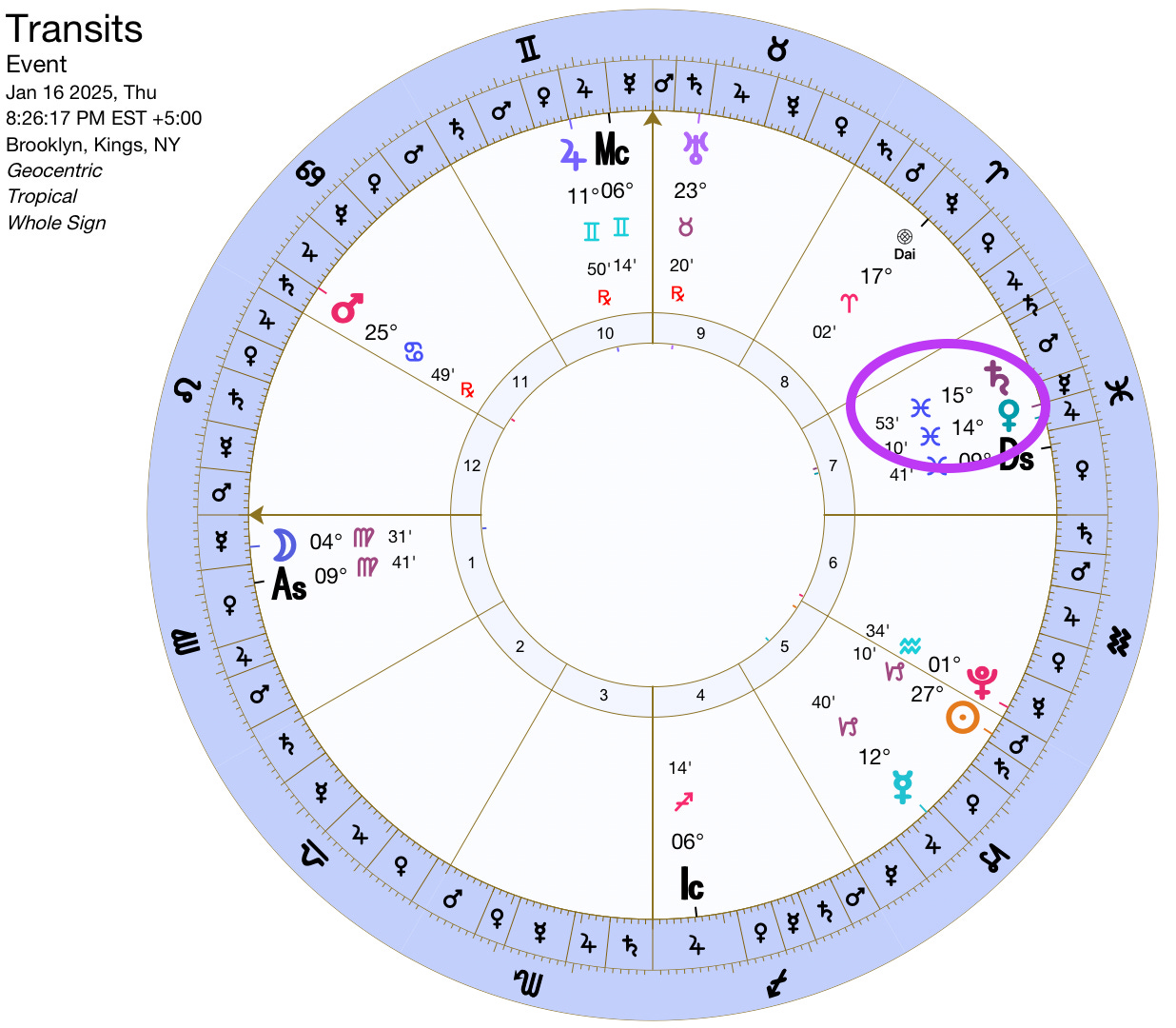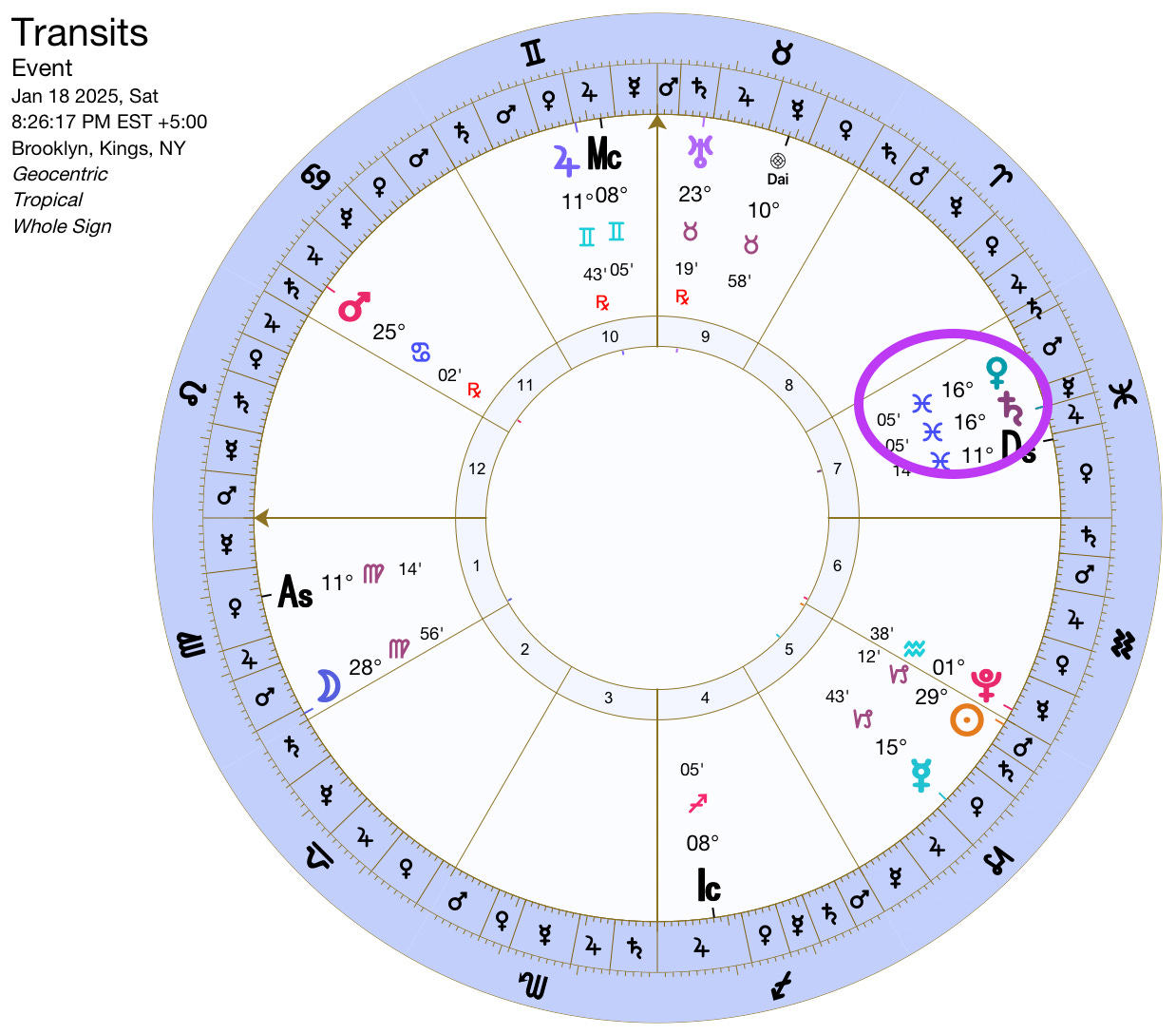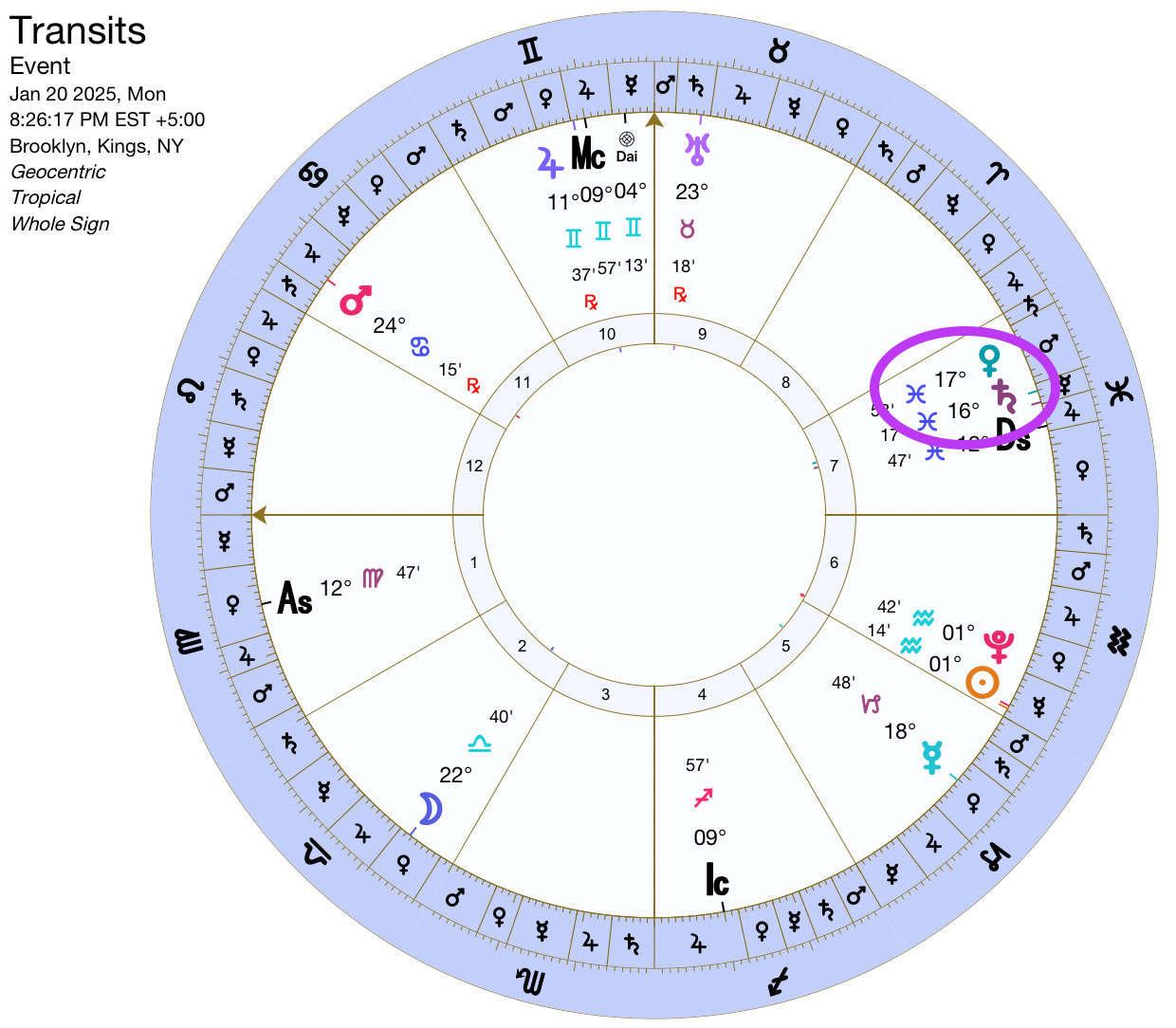conjunction junction, what's your function?
celestial bodies hooking up
This post is an interlude between my “intro to fixed stars” post and a post about interpreting fixed star conjunctions. I thought conjunctions themselves deserved their own ode.
I’ve got a recording of the post here in case listening suits you better than reading right now.
oh god, aspects
When studying astrology, the first things you learn, usually, are the qualities of the zodiac signs and the planets, and the topics of the houses. Then come aspects. This is where a lot of people go, “Okay, this is a bridge too far.” Aspects feel like math and they add a layer of interpretation that can be brain-breaking.1
It was like that for me and I hear the same from my clients all the time. It took me a while to get confident enough with aspects to know when to bend their rules (which is when the good stuff happens in my opinion).
Because aspects are such a swirly learning chapter for enough people I know, I figured that before I show you how I interpret fixed star conjunctions, I should talk about conjunctions in general.
but first! my april booking calendar is open
My books are open for April! You can book here. I’ve got availability for one-on-one readings and planetary telegraphs.
While I offer year-ahead and general birth chart readings, and love doing that, I specialize in the fixed stars and would love to talk to you about yours.
My other long-standing love is for the 5th house, which gets its own focused reading so we can go deep on play, pleasure, joy, and creativity (and the barriers to them).
While we make things in the 5th, we toss them up over the horizon line to be caught by people found in the 11th house. My 11th house reading is all about the troubles of sharing what we create and the specific struggles each of us has navigating (really different) group-dynamics — whether with friends, community, and “audience.”
A client who received an 11th house reading this week sent this through:
“It's really hard -- almost impossible! -- for a stranger to tell you stories about yourself that feel both new and deeply true after speaking for under an hour. Maeg -- a wonderful listener, gifted astrologer and generous spirit -- did just that. Our 11th house session left me feeling deeply moved and more alive.
Maeg invokes language that brings the spirit of the stars to life in bright colors and wild characters. She was able to get granular about details of my creative process, inner voices, and true desires in ways that re-shaped my self-concept and helped me move through stuck energy and stories.
Maeg is abundantly knowledgeable, caring, sensitive, and imaginative, molding a totally unique reading that feels therapeutic, psychedelic, and personal. I left feeling like I had untangled something and given birth to something else... I'm so grateful for our time together and for her gifts!”— P. F.
I’m so grateful to get to do this work 💛
Now onto today’s post on conjunctions.
conjunction junction, what’s your function?
Some of you already started singing this song in your head the second you saw the title of this post. For the rest of you, may I present Schoolhouse Rock, a cartoon program that set out to teach children about grammar, science, history, and math using catchy tunes. Schoolhouse Rock had a song called, “Conjunction Junction, What’s Your Function” to tell kids about how to use grammatical conjunctions, words like “and” “but” “or,” and how these conjunctions create complex sentences.
Despite growing up with this program, this is the only song I remember from it.
Conjunctions in astrology share a lot in common with their grammar cousins. Astrological conjunctions describe a stickiness, a bringing together of two or more things. A planetary conjunction may be additive (like the word “and”) or contrasting (like “but”) or present a conflict that seems to require a choice, very something’s gotta give (like “or”). Like grammar conjunctions, astrological conjunctions make complex sentences too. They have more going on in terms of their needs and meanings than a planet would have all on its own.
Grammatical and astrological conjunctions share qualities because they share a history. If you look up the etymology of the word “conjunction,” you’ll get:
conjunction [n.]
“a joining or meeting of individuals or distinct things,” originally of planets or stars “meeting” in the same part of the sky, from Old French conjonction “union, joining, sexual intercourse”… Grammatical sense of “connective particle serving to unite clauses of a sentence or coordinate words in a clause or sentence” (late 14c.)
Schoolhouse Rock says conjunctions are about “hooking up two boxcars and making ‘em run right.” When a planet meets another planet, it’s a conjunction. They hook up like two boxcars. Once they do that, are they two separate boxcars or do they become a train? They are both.
A conjunction is a relationship. Like all relationships, a conjunction changes the beings involved and calls into question who is who: what is distinct and what is blended. Depending on who is hooking up, it could be a harmonious or contentious experience. It could be sexy or awkward. It can be that one planet overwhelms the other, or they could meet in the middle.
If you are into this post and find yourself wanting more, there’s a way to make sure that happens! Free subscribers get the occasional full post and tasty slices of the rest, but paid subscribers get the whole damn feast.
witnessing vs. proximity
If you look up conjunctions in most traditional astrology books, conjunctions will be included in the list of the traditional aspects (the others being oppositions, squares, trines, and sextiles) even though, as most authors will add, conjunctions aren’t technically aspects. Aspects are about sight. Planets in aspect aren’t near each other but they can see each other with the benefit of distance. They bear witness to each other.
Conjunctions, on the other hand, are not about sight. They’re about proximity. They are intimate. If Venus is conjunct Mars, Venus isn’t witnessing Mars from her own perch. They are in the same place and they are dealing with each other. Venus may be fighting with Mars. Maybe she’s rallied by Mars or riled up by Mars. And Mars, in turn, is probably getting seduced by and battling Venus in turn. They are their own separate planets and they are also a third VenusMars thing. It is a blending: it’s blue paint and yellow paint but also it’s green paint now.
Planetary conjunctions put a lot of power in one place, forcing it to act as one, even as it may struggle against itself, as the two or more planets resist and embrace each other. When two or more planets are together, there is a gravitational pull in that part of the chart. There’s strength in numbers, sure, but it can be a stubborn knot of interests.
how do you know if it’s a conjunction?
The quick and dirty version is: if planets are in the same sign and they look pretty close to each other, it’s a conjunction. The tighter the conjunction, the more intense the blending. If that’s good enough for you, it’s good enough for me.
If you want to get more specific, I will turn to Ancient Astrology in Theory and Practice Volume 1 by Demetra George. She outlines the stages of intimate proximity between two planets.
Planets in the same zodiac sign, regardless of how far apart they are, are considered “co-present.” By simply being in the same sign, they are already co-mingling their significations.
If a faster-moving planet2 is approaching a slower-moving planet, and if they are within 15° of each other, it’s an “assembly,” or a loose conjunction. This concept approaching is also called an “applying aspect.”
Same deal but let’s say the planets are now within 3° of each other. Now we’ve hit a new level of closeness. I like how Demetra phrases this: it is “a gluing, a bonding, an adherence.” This is a conjunction. (The Moon is an exception. When the Moon is applying to another planet and is within 13°, it counts as a conjunction because the Moon is special.)3
(There’s also a moment when the two planets are at the exact same degree and arc minute, which is an exact conjunction. Demetra does not mention this because Hellenistic astrologers did not make a super big thing of it. As long as the planets were applying and within 3°, that’s what they cared about.)
If the faster-moving planet has passed the slower-moving planet, it’s not a conjunction (or “adherence”) by these standards even if they are super close to each other. This is because conjunctions, from this perspective, are about arrivals and meetings, but not departures. Demetra calls this state “flowing away.” More commonly, it’s a kind of “separating” aspect.
For my part, if the planets are still in pretty close proximity, I still consider it a conjunction even if it is separating. I just take into account the vibe of departing rather than arriving. Leaving does not mean severing. Is the planet leaving in a huff? Is the planet leaving and wishes they could stay? Are they wistful? Are they befuddled? What’s the deal? That’s what’s most interesting to me.
What counts as “pretty close,” you ask? I couldn’t say. I feel it out. Really, if it’s your chart, I think the question is not “what do the rules say” but “how does it feel to you? does it feel like these parts of your life are bound up together?”
example of an applying venus-saturn conjunction
I find visuals useful so here’s a few visual examples in case this idea of applying and separating is new to you.
Venus and Saturn are conjunct in this chart. Venus is faster than Saturn. Here she is at 14° and Saturn is at 15°. Venus is at an earlier degree so she’s on her way to him but has not yet arrived. This means it’s an applying conjunction.
example of an exact venus-saturn conjunction
example of a separating venus-saturn conjunction
Venus is in a later degree than Saturn, so she has passed him and is heading away from him. They are separating.
as intimate as sex
Conjunctions are as intimate as a fight. They are as intimate as sex.
I joked on Bluesky that my brand is “astrology as a front for celestial erotica.” It’s only sort of a joke, so it’s very on brand of me to say something like “conjunctions are sex.” But it’s not just me! Scroll back up and see the etymology again. It says “conjunction” comes from an old French word for “sexual intercourse.” Demetra George! herself! says, “Adherence is the closest kind of relationship. It points to the deepest kind of intimacy between planets; the two merge into one, as if in sexual union.”4
Each aspect is said to be of the nature of a planet: Saturn has the opposition, Mars the square, Jupiter the trine, and Venus the sextile. I know conjunctions are not technically aspects, and Venus technically already oversees the sextile, but who is going to tell me conjunctions don’t belong to her too? They do. I know it in my bones.
While we’re here, would it be helpful if I created some posts to walk you through the other aspects? Would you be into that? Let me know in the comments.
questions for consideration
When you’re thinking about conjunctions, here are some questions you might ask. Many, but not all, of these questions will be relevant for fixed star conjunctions too so keep ‘em in your back-pocket for the next post.
Who is meeting up? What are they each like on their own? What are they responsible for?
What might they desire about each other?
What could they offer each other (whether or not it’s wanted)?
Do they balance and/or exaggerate each other?
Are they at odds? If so, does one dominate? Is it a stalemate? Can this change?
Is there any benefit to their tension?
Where do they find common ground?
If they merged into a mega-planet, what would that planet be like?
How does the sign and house they find themselves in describe the quality of their encounter?
Are they coming together or departing? How does that change the scene?
fixed star conjunctions
If you’ve read the first post in my fixed stars series, you know conjunctions between planets and stars work a little differently than planet-to-planet conjunctions.
In my next post in this series, I’ll share how I interpret fixed star conjunctions, with an example, and offer some resources for where you could look up some star-specific delineations to get you started with your own.
After we cover fixed star conjunctions, I’ll move to the other method for identifying and interpreting fixed stars in the chart: parans. But your fixed star conjunctions won’t go anywhere. They’ll come along for the paran ride.
in the meantime
If you’d like to talk about your conjunctions (planetary and stellar), or anything else astrological, I’m here. Let’s chat in the comments, and/or come see me for a reading!
Astrology software makes aspects more intimidating (I think) by using aspect lines. Jo O’Neill made a funny and useful (as always) reel on Instagram about this very thing!
If you’re wondering “okay, but how would I know who is faster?” Generally, most to least speedy: Moon, Mercury, Venus, Sun, Mars, Jupiter, Saturn. It gets a little dicey with Mercury and Venus and Mars if you are comparing them to each other. This relates to their retrograde cycles. If you want to be really sure, you can check a tool like this ephemeris which shows how many degrees each planet moves on a given day in comparison to each other. You also can just say, “I don’t actually care if the planets are applying or separating for my level of interest in astrology; I just want to think about what it means that these two guys are so close to each other,” and that’s totally fine.
The Moon is the special-est, it’s true. She gets a wider threshold because of her super-speed compared to the other planets.
Bonus for the astro-nerds who love the bounds or terms: Demetra says there’s an even closer relationship than adherence and it’s called “‘juxtaposition’ or neighboring. It occurs when two planets are in an adherence (3° applying bodily conjunction) and they are also in the same bounds.” If you’re reading this and thinking, wait, what are the bounds? Check out Kira Ryberg’s work on them.








posts walking through the other aspects would be greatly appreciated. i've been thinking about my venus and mars, which are loosely conjunct (i think) but in different signs. living through this moment where they're in some kind of dance in my life, i appreciate the questions for consideration to get curious about all the exposition that leads up to the waltz/shuffle of today.
I HAVE LOVED THIS SO MUCH UGH ❤️🔥Really really cool idea to first introduce conjunctions before fixed star conjunctions. Looking forward to the next article for sure and also, would definitely be pleased to read more from you about aspects!